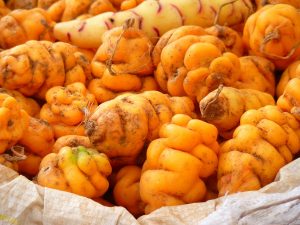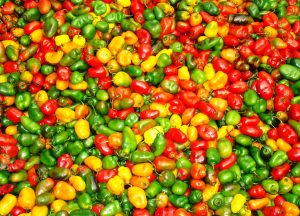Ok Super Sup’ers, are you ready?? We are going on a journey to Peru, sooooo…. alpaca your bags! Get it?? Alpacas are native animals to Peru. But we are not here to learn about alpacas…we are here to learn about Peruvian food. So, let’s get started!
Did you know that Peru is one of the most biodiverse places in the world? That means there are many different kinds of plants, animals, and climates. In fact, out of the 32 climates on Earth, Peru has 28. Peru is also home to 84 of the103 ecosystems! From tropical and desert climates, to warm and dry coastal climates, to mountainous cold and rainy climates, Peru has it all! What does all of this have to do with food in Peru you ask?? Well, it simply means that the variety of crops that can be grown in Peru is extremely diverse, making Peruvian dishes full of flavor! I am going to tell you about 3 of the main crops in Peru: Potatoes, Corn, and Peppers.
 I have soooo many potato jokes, I don’t even know where to starch! So I’ll just starch, um…I mean start, with the fact that the potato is the most important plant in Peru. This is because Peru is said to be the birthplace of the potato! Believe it or not, Peru has over 3,000 different varieties of potatoes! Some of the amazing varieties include:
I have soooo many potato jokes, I don’t even know where to starch! So I’ll just starch, um…I mean start, with the fact that the potato is the most important plant in Peru. This is because Peru is said to be the birthplace of the potato! Believe it or not, Peru has over 3,000 different varieties of potatoes! Some of the amazing varieties include:
- ‘’Puma Maki’’ which means “pumas claw”. It has grey on the outside and purple on the inside and its shaped like a claw!
- ‘’Puka k’usi’’ — “red pumpkin”
- ‘’K’achun waqachi’’–“the one that makes the daughter in law cry”.
- “Kusi k’achun waqachi”– “makes the happy ones cry”
Instead of cracking a corny joke, let’s get right into it! Corn is one of the most widely used ingredients in Peruvian cuisine. Peruvian corn has been planted in the Andes since 1200 BC. A 16th century writer from Spain, Bernabé Cobo, wrote about how in Ancient Peru one could find corn in “every color under the sun: white, yellow, black, red, purple”. In Ancient Peru, corn was known as choclo, and sometimes called Sara (like my sister!). Peruvian corn is sometimes made into Cancha (Andean toasted chulpe corn). Sara and I tried this toasted corn. It was crunchy, salty and a good snack! Today, farmers along the Peruvian coast, the Andes, and the jungle, grow more than 55 different types of corn.
Have you heard this one? The aji amarillo asked the aji limo, “are you cold?” and the aji limo answered, “I’m not cold, just a little
chili”. Haha..get it?? Aji is Spanish for “chili pepper”, and Peru has about 300 different varieties! Some people think that the aji amarillo (yellow pepper) is the most important ingredient in Peruvian cuisine. This could be true because it is the staple ingredient in important Peruvian dishes like: causa rellena, aji de gallina, escabeche, cau cau, and papa a la huanaina. Aji panca is another traditional Peruvian pepper. It grows in the central coastal region of Peru and is usually dried or made into a paste. Usually only traditional Peruvian markets have fresh aji panca. Chefs all around Peru use aji panca in dishes like: adobos, escabeches, pachamancas, parihuelas and chupes. Some other varieties of aji that are native to Peru are: aji charipata, aji limo, and aji mirasol (which is actually dried aji amarillo).
Well, I hope you had a nice trip to Peru with me. I have really enjoyed learning about the varieties of Peruvian crops. Trust me, there is so much more to learn! Check out the links and videos below to learn more.
DIG IN!
Check out these sources where I found a lot of good information for this blog:
- https://howtoperu.com/category/about-peru/peru-geography/
- https://www.youtube.com/watch?v=p9qWJ89m-hY&t=37s
- www.specialtyfood.com
- I also watched the Peru episode on a show on Netflix called Chef’sTable, I strongly recommend it!

Very well done 👍